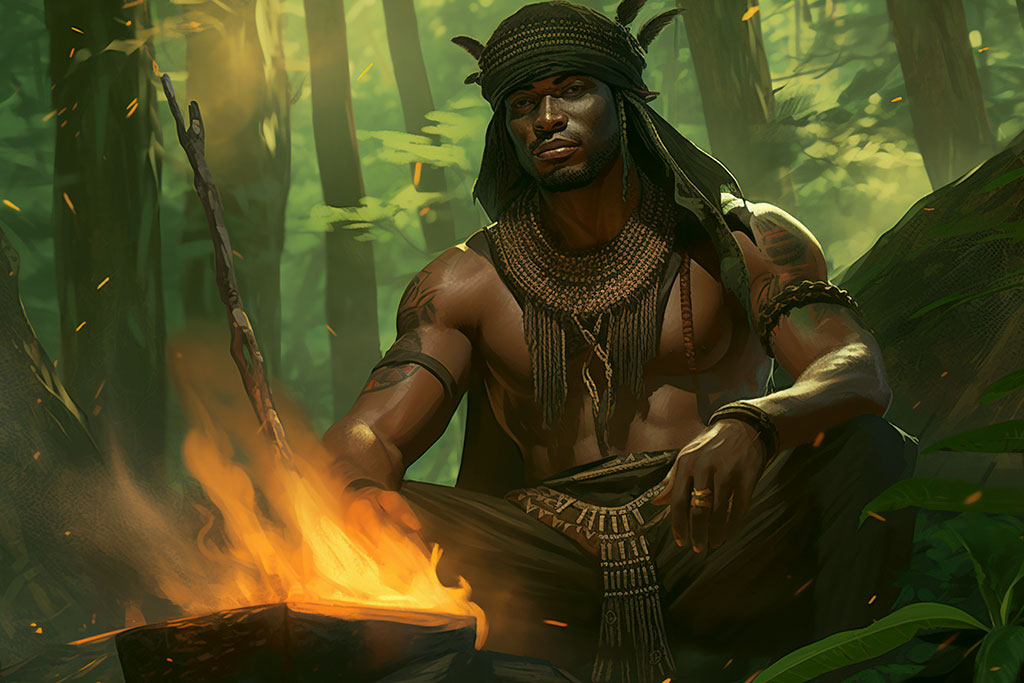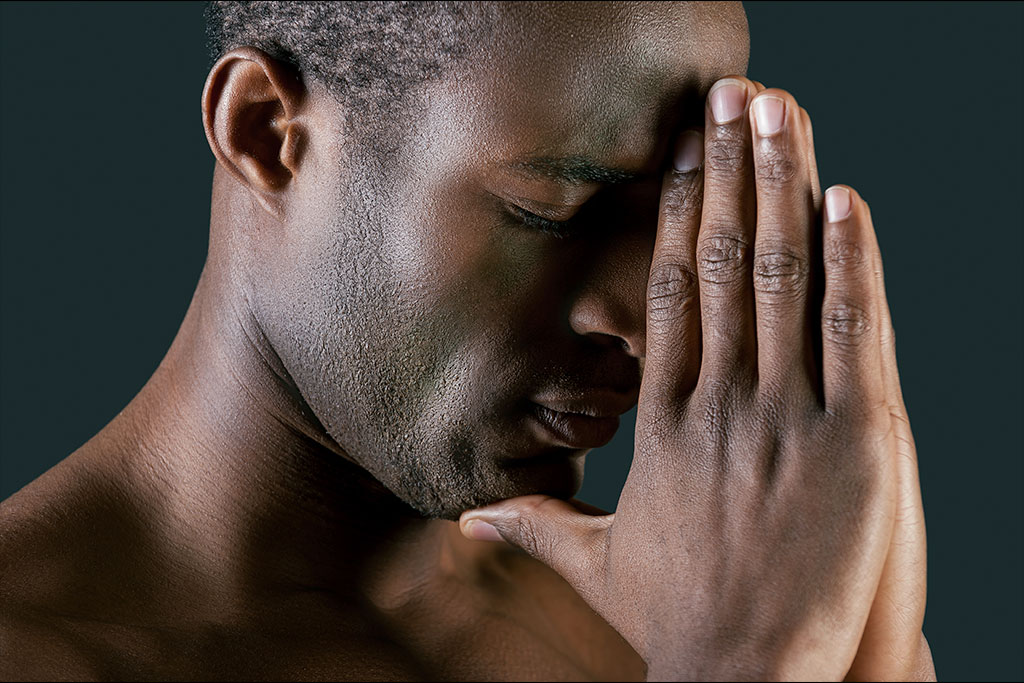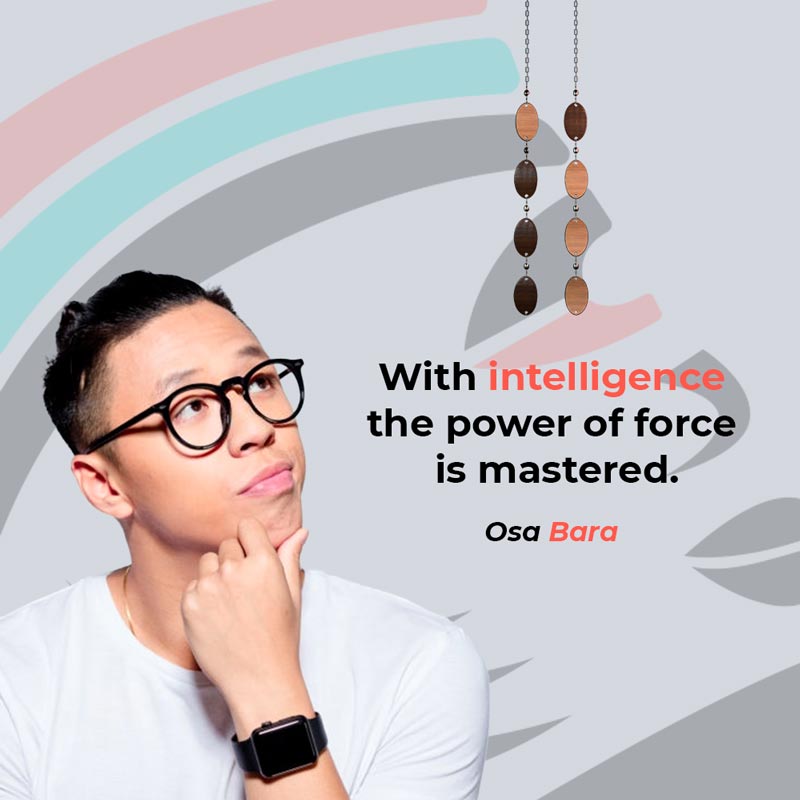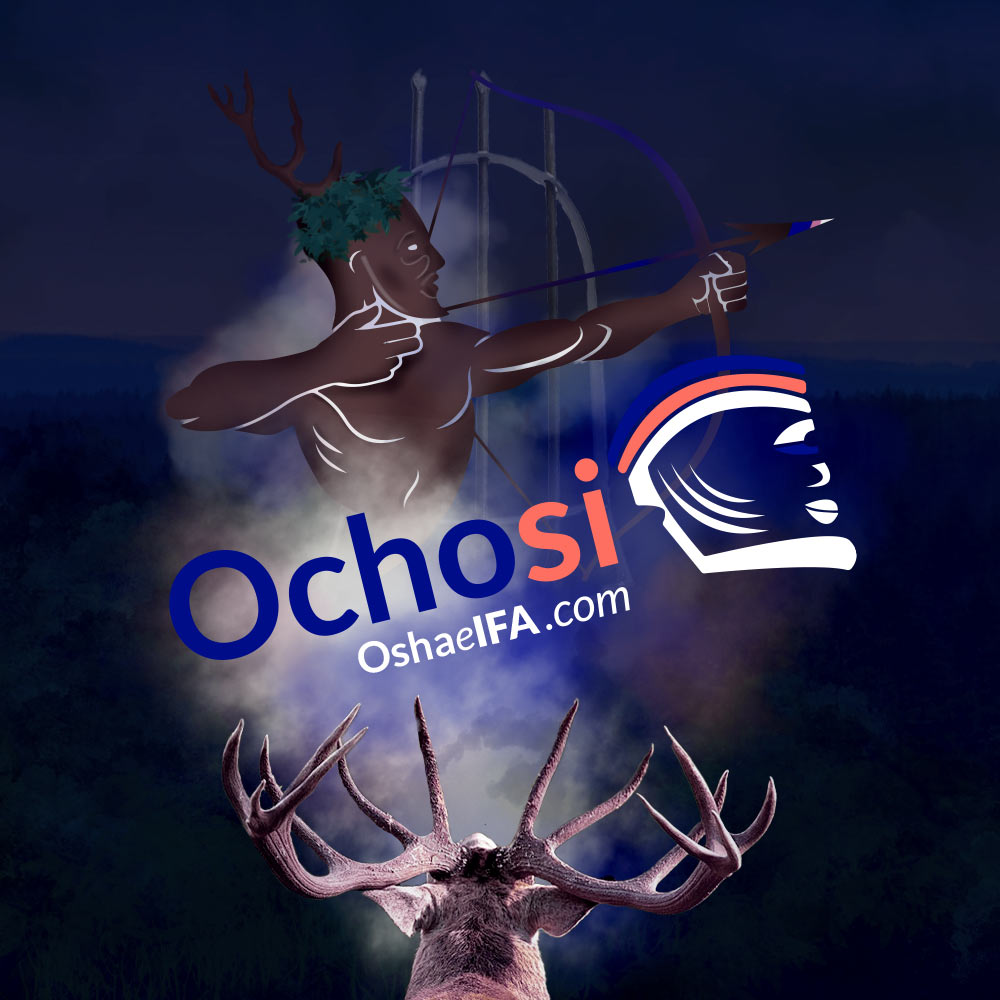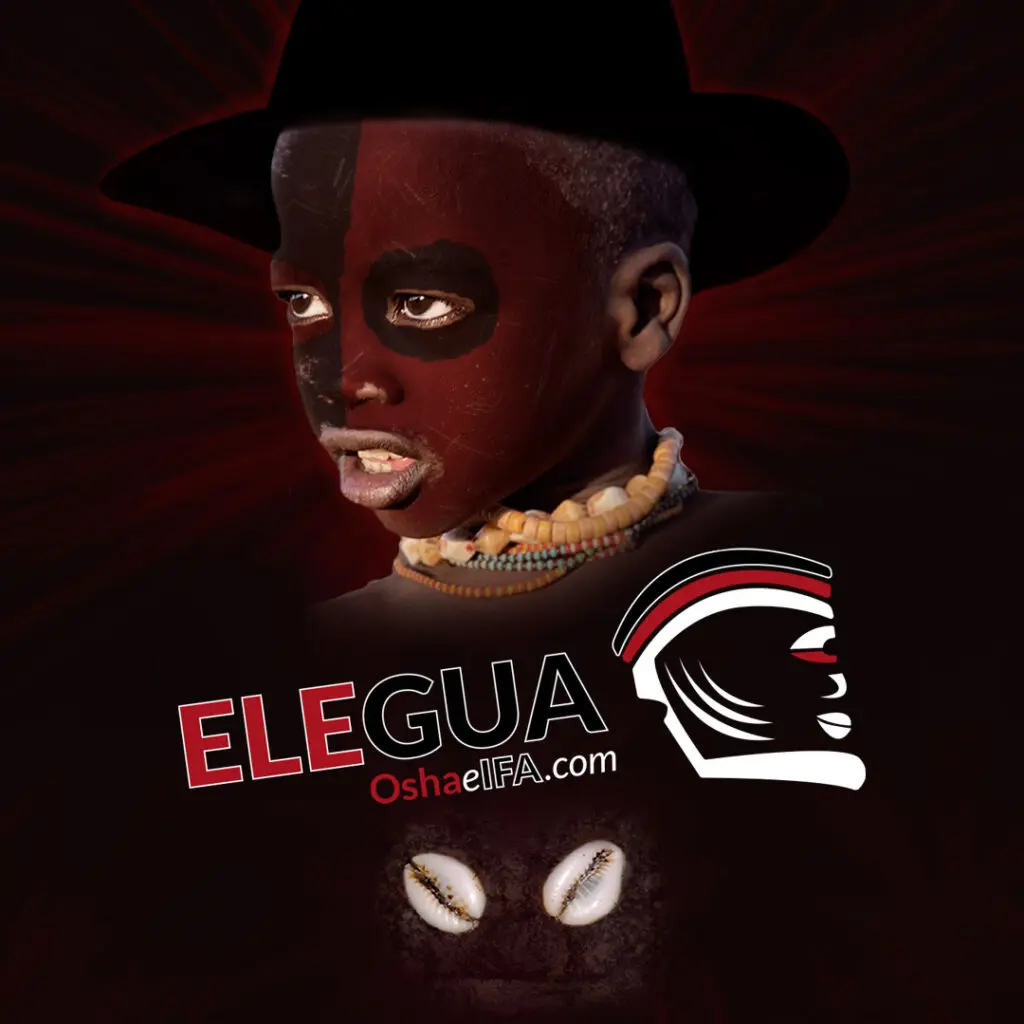Oggún: Orisha of the metals of the Yoruba pantheon
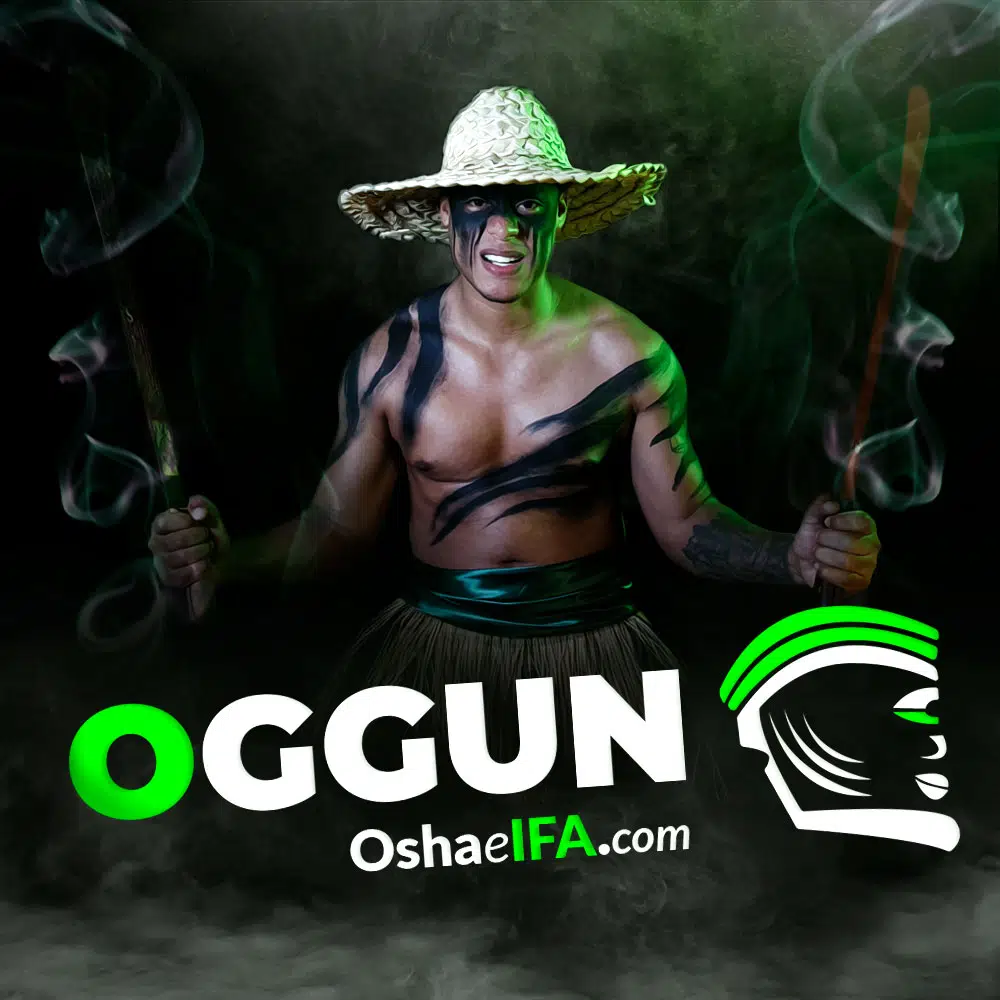
Oggún is revered as the Orisha with the greatest physical strength among the 200 divinities of the Yoruba pantheon. He is considered the owner of the smithy and all the metals. Consequently, he is also considered the master of all objects that are made with these materials, for example: work, surgical, technological instruments and, of course, weapons, which have made him a particularly influential deity in wars. thanks to that element, and his status as a warrior in the company of his violent and explosive character.
Therefore, its energy is also present in all the minerals, in the mountains, in the forest, the savannah and in all the bushes of the mountain. He is the protector of blacksmiths, mechanics, engineers, physicists, chemists, surgeons, soldiers, hunters and all professionals or craftsmen who work with metals.
If we talk about Oggun as a deity, he is among the oldest divinities created by Olodumare. He is one of the Ada Orun, that is, he was created at the beginning of time directly by God, and his most primitive function is to give shape to the creative principle of the Almighty. One of his first actions was to shape the celestial bodies, through the composition of what we now know as physical laws.
His hierarchy is so high that in the absence of Obatala, he is authorized to preside over the Divine Council, as he is the oldest deity after him. During the gestation of the fetus he exerts its influence on the creation of the bones of the human skeleton.
Its natural habitat is the thickness of the mountain where it works tirelessly. He knows all the mysteries of it and moves fully. He is the inseparable companion Ochosi, and from his brother Elegua; Orishas with whom the trilogy known as "the warriors" forms, always live together both in the mountains and in their foundations, which are normally placed at the entrance of the houses of those initiated in the rule of Osha and Ifa (also known as Santeria ).

In addition, he is considered a very skilled sorcerer who knows the secrets of sorcery and the spiritual wars caused through the Eggun.
Among his powers, he is credited with being in charge of the immolation of the animals that are offered in sacrifice to all the Orishas, for which he is the owner of the slaughter (ceremony that includes some animal sacrifice), since both the knife , as the physical force exerted for such a ritual belongs to him and thanks to this, it is said that he eats during this, even before Eleggua, due to his participation in this action.
The Yoruba define Oggún as a master artist, because he is credited with giving the final touches to Obatala's sculpting work. He is also entrusted with circumcisions, tribal markings, tattoos and everything related to surgical operations. He considered the holy protector of orphans.
In Nigeria it has a very particular function in carrying out oaths, alliances and agreements. This is because he is considered the guardian of the truth of Ifa. In African lands it is vehemently believed that whoever swears falsely or who violates an agreement in which Ogun has been a witness will not escape his trial and sentence, which generally manifests itself in terrible accidents. Adrián de Sousa Hernández (2005), in his book The Orishas in Africa, states that:
"Currently, when a Yoruba practitioner of the traditional religion is brought to court, they are asked to swear on Oggún (represented by a piece of iron) instead of on the Bible or the Koran." (p. 92).
Within the ambivalence that his features possess, it is also interpreted that Ogun can have attitudes of self-sufficiency, stubbornness and impulsiveness, which cause great revolutions and conflicts, becoming an Orisha at times solitary and resistant, or malleable and protective, as The metal could turn out depending on the conditions to which it is subjected.

Diane Caudillo (2007), in her writing Prayers to the Orishas to look at Santeria, notes that: «Ogún has a reputation for being violent and short-tempered, but this is not the whole story. He can be invoked for strength and support, stamina and perseverance ». (p. 8). This means that, beyond these characteristics, it is necessary to delve into his nature to truly answer yes, Ogun is gross? a recurring question within his cult in Afro-Cuban practices.
This question arises from some misinterpretations about Ogun that point him out as a "gross" Orisha or lacking in intelligence, a statement that is quite false and incoherent. Although his personality and physical nature is charged with great strength that, together with his title as a warrior, makes him be described as a hostile and destructive Orisha, as explained above, this is only one facet of this Orisha.
Oggun in Nigeria is a symbol of a high hierarchy within all the perspectives that are analyzed. Another reference that we could cite is that originally the work carried out by the blacksmiths had great status within society. That is to say, it was not just a work of physical strength, therefore, relating Oggun to that work highlights its importance.
This Orisha is capable of developing excellent skills that require the use of knowledge accompanied by physical dexterity, an example of this is his wisdom in the arts of sorcery, ancestral medicine, metal work, his influence on the evolution of science, chemistry, and physics, among many other abilities that have been sufficient reasons to entrust him with important attributions.
In addition to this, he is the father of culture, a symbol of human evolution. He is present in the development of the human being from the beginning of time, in the primitive tools and techniques, up to the technological and industrial advances of today. That is, it is the beginning of transformation based on knowledge. This is stated by Ifa Orilana Aworeni Odumola Sowunmi (2009), in his book The nature of the Orisas, when he states that:
«Ògún is the one who paves the way for man in the elaboration of practical tools for life, and for socialization, work in common, help, work among social groups to sustain themselves later on in the realization of a common project». (p. 169).
His presence has been necessary so that we can be what we are today. And he is not only limited to the topic of instruments, he is also part of the community. Oggun is productive teamwork and social nature in being. All this has been for the benefit of humanity, but at the same time, it has caused conflicts and given rise to wars. As can be seen, his energy has been decisive in the way in which man has shaped his history.
Tools, attributes and powers of Oggun
Its foundation is made up of an otá (stone) that lives inside an iron cauldron with three legs that contains tools: a knife, a shovel, a rake, a spear, a hammer, an anvil and a bow with an arrow. Additionally, all kinds of iron tools can be placed as reinforcement such as: chains, horseshoes, nails and pieces of train line, hooks for hanging cattle, horse bits, swords, knives, picks, shovels, metal mass, everything type of weapons, among many others.
In their sanctuaries in Yoruba land red rooster feathers are placed on him, which represent his authority; a foundry furnace, a line rail and a mandarria.
Oggun's most characteristic tool in the rule of Osha and Ifa (Santeria) is the machete, and in Nigeria the double-edged sword, with which he wages all his wars, opens the necessary gaps to advance on the path between the spiritual world and earthly, as well as, among the thick undergrowth. These weapons are also loaded with symbolism with a sexual connotation, since it represents his great virility, strength and masculinity.

Due to syncretism, in Afro-Cuban traditions Oggun's day is April 23. However, his celebration occurs in a different way in Nigeria, where a festival is held in his name, known as the "festival of the Living and the Dead", this being one of the most important in Ife, Ilesa, Ondo, among others. other Yoruba regions.
During the three days in which this commemoration takes place, whose date is previously determined by the traditional council of Ife chiefs, sacrifices, drumbeats, dances, songs, prayers, and ceremonial processions led by the Ooni are performed. from his palace, to the sepulcher of Oggún, where the ritual of crossing swords is carried out.
A very curious legend about this event is that it is forbidden to fight during the festival, because it is believed that: "you never know who is next to you, it could be a spirit or a mortal".
With regards to sacred number of Ogún, 7 is attributed to him and its multiples. It is also identified with the digits 2 and 3. In relation to the number 7, this has always had a sacred character since ancient times and cultures. The Babylonians associated the number 7 with the celestial bodies; It is also related to: intellectual capacities, good fortune, wisdom, perfection, and with the proportions, shapes and dimensions of the bodies of nature. All these elements with which Oggun has a deep relationship.
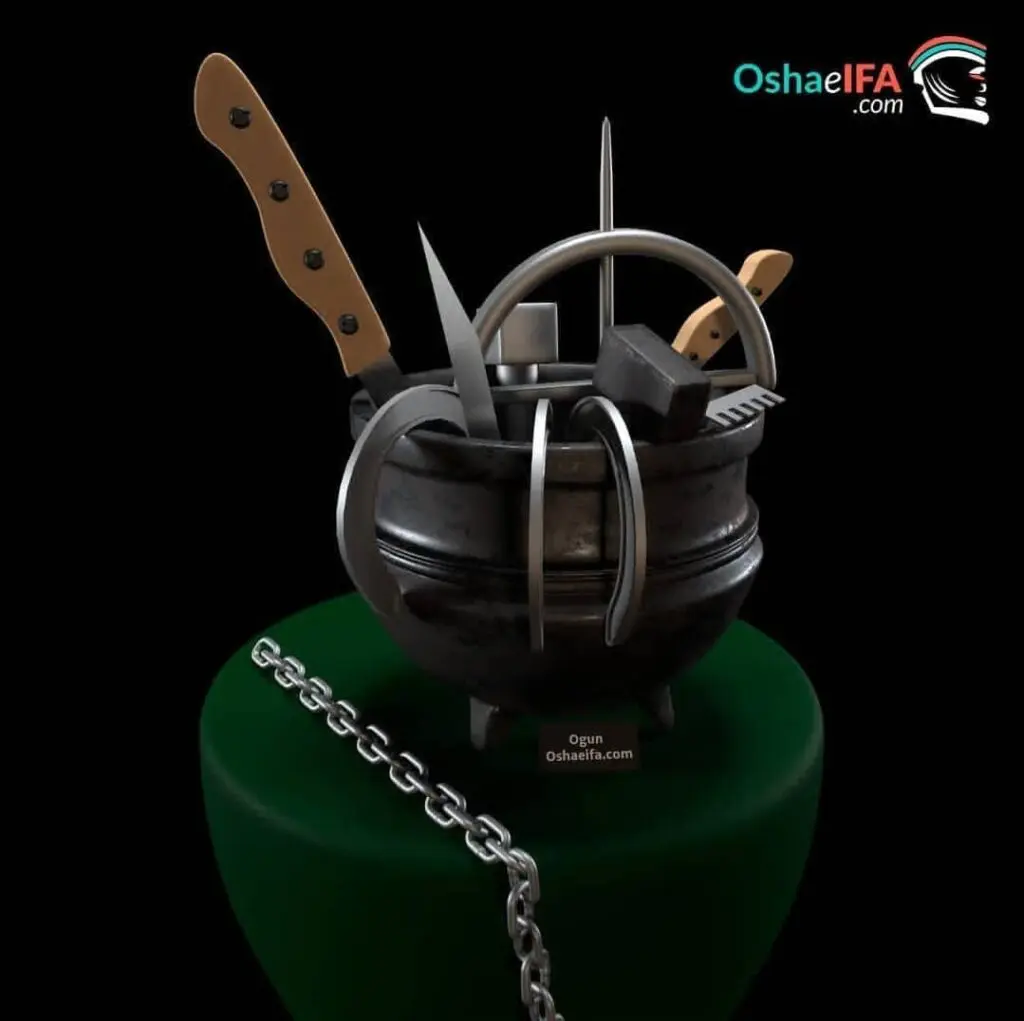
Inside the Afro-Cuban customs its colors are green and black, but, it is also related to red, indigo, white and purple. However, Adrián de Sousa Hernández (2005), maintains that: "The color associated with this deity in Yoruba lands is indigo blue."
Oggun's characteristic clothing or suit consists of a vest and short pants, usually made of sackcloth or colored fabric. He wears a hat and a bag across his chest and a mariwo (belt made of dried palm leaf straps) hanging at his waist.
«Ògún made his first clothes, with Maríwo (palm fronds), and the threads of the Maríwo were used to cover his body. Temperamental and brave, he inspired fear and great respect among the inhabitants of the ancient land ».
Ifa Orilana Aworeni Odumola Sowunmi. The nature of the Orisas. (2009, p. 171).
Oggun's necklace and ilde (bracelet) It is made with green and black beads organized in multiples of 7 and 3. The herbs (Ewe) that are used within the rituals and works of Ogun They are: Pacific sea, peregún, bitter yellow plum, purple basil, avocado, carob tree, wild basil, san pedro vine, calalú, carbonero, holy cane, holy thistle, ten of the day, treasury, fine grass, ginger, Chinese pepper, pine nut milky, bankruptcy ax, okra, tobacco, blackberry, yucca, among others.
During the ritual celebrations, when this Orisha incorporates a saint's horse, his dance is very strong, full of grace and skill, but loaded with strength and virility. He dances holding the machete, making movements that pretend to be clearing the brush or using his work tools. He is usually a very serious Orisha and his advice is full of much wisdom.
The followers of Oggun in Nigeria, iron and steel workers, Yoruba hunters, soldiers, drivers or forgers, do not start their work without entrusting themselves and paying the respective tributes to this deity, waiting for their protection against accidents and help in their work. .

in santeria, Oggun is also asked to intervene in the labor affairs of his devotees, both to obtain a job, and to protect himself when performing his tasks when they involve the use of metallic instruments. In situations related to health, Oggun is also opportune, especially if they involve surgical operations. In cases of wars and conflicts, both physical and spiritual confrontations (witchcraft wars) Oggún is invoked as a warrior to protect us and make us win the fight.
In the same way, Oggun is an Orisha that promotes prosperity and development. Also, he is associated with clearing the path or removing barriers, therefore, he is invoked, to defend ourselves against difficulties that we cannot remove on the way to our goals.
You can read: Children of Oggun: How are they? Names and Prohibitions
History and legends about Oggun
The Yoruba culture believes that, in the earthly incarnation of Oggun, he was the Ooni, that is, the king of the city of Ife, and of the city of Iré in Nigeria, successor of Oduduwa after his disappearance. It is for this reason that his cult identifies him as a deified ancestor, while he is also described as a primal divinity.
A popular story of Oggun as an ancestor states that he is recognized as a powerful warrior who participated in various confrontations with the enemies that stalked his people and his father. That is why Odduduwa granted him the kingdom of Ire, in recognition of his merits. In that place he is known as: Ogun Onire.
«It is said that the current king of Iré (onire de Iré) proclaimed himself a descendant of Ogún, recognizing him as the first king of that population, and also says that he (Ogún) was not reigning there for a long time, and that he abandoned the town very dramatically."
Shango Omo Asa. Orisha's power. (2021, p. 29).
However, there are other regions of Nigeria where this saint is also deeply worshiped, which gives rise to it being known by other names or customs, preserving its fundamental essence as always.
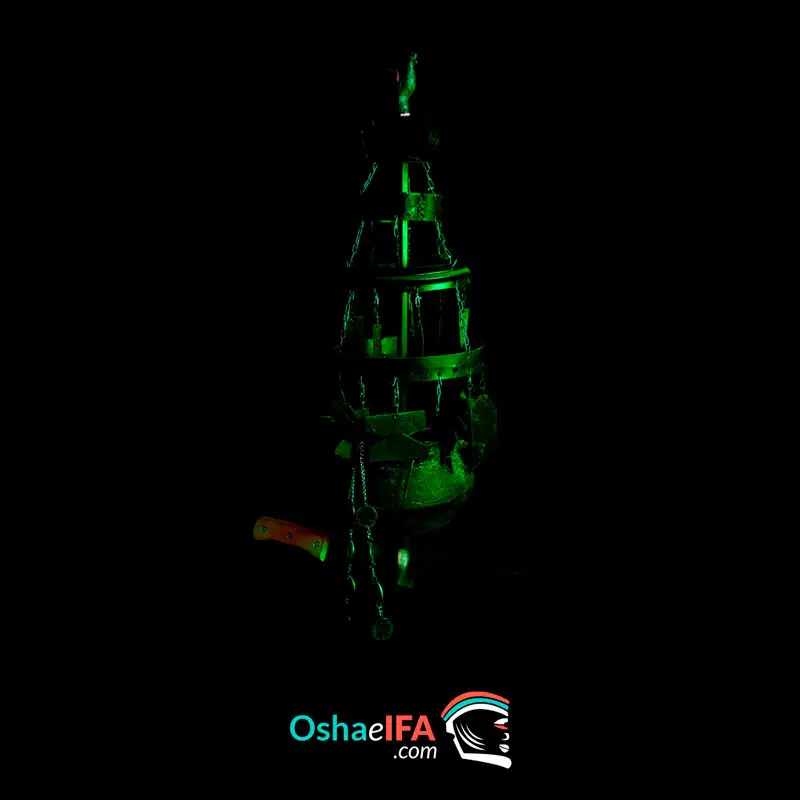
Going back to the legend, it is said that after an exhausting battle, Oggun returned to Ire, finding the people of his town gathered in Ajo Oriji, that is, in an assembly where greetings were prohibited, but he was unaware that it was carried out. perform this ritual and was surprised because no one greeted him. Immediately afterwards, he with his machete touched the barrels of palm wine that were in the center of the assembly, but they were empty. Then he was offended, a great rage grew within him and he lashed out at his own subjects.
Feeling exhausted, he reacted, observing what he had done, seeing the misfortune he had caused, for which he was dismayed and buried his sword in the ground forever, and then sat on it and disappeared; promising that he would always come to the call of his people. Let us remember that, for the Yoruba, the Orishas or hero ancestors, worthy of worship, do not die, they disappear, and this is one more example of that mythological perspective on the matter.
Pataki on Oggun's arrival on Earth
Oggun is one of the oldest divinities created by Olodumare (God). His odu isalaye (in which he descends to Earth) is Ogunda meyi. In this Odu de Ifa he identifies himself as "the discoverer of the path", because he led the second reconnaissance mission to populate the world, moving from heaven to Earth; mission that was entrusted to him thanks to his outstanding strength. Shango Omo Asa (2021), refers that:
«It is said that he came accompanied by a dog and a large metal ax, with which he opened the way for the other Orishas, that is why it is said that Ogún is really the one who opens roads and not Eleguá, although Eleguá is the one who he takes care of the crossroads or crossroads, he himself, has other relationships with the opening of possibilities and closely related to the Ashé of Olodumare of which he is his custodian». (pp. 27-28).
His story tells that when Oggún was entrusted by Olodumare to come from heaven to populate the Earth, he agreed to carry out his mission, but he did not bother to seek advice or consult with the diviners of heaven, since he considered that by possessing I didn't need that much strength. As soon as he received the order to depart from God, he immediately set out on his march. Olodumare granted him 400 followers to accompany him. Upon arriving on Earth, he realized the mistake he had made in not preparing the game as necessary.
His mortal companions were immediately hungry, but, since they did not bring food, they found themselves in need of eating sticks, which is why they became ill and began to die. Ogun upon seeing such a situation quickly returned to heaven to report the unfortunate situation and the imminent failure of his mission. Olodumare summoned Olokun, the divinity of water, to lead the second expedition to Earth. Who, accompanied by 400 followers, like Oggun, left for Earth without making any sacrifice, finding himself in the same unfortunate situation upon arrival.
Olokun recommended his followers to eat water, later starving, forcing him to return to heaven without success in his mission. Next, the same mission was entrusted to Orunmila, who, accompanied by 200 men and 200 women, would go down to Earth with the intention of populating it once more. Orunmila consulted with his faithful servant, Okpele, to make the appropriate preparations to achieve success in his mission, he predicted that success awaited him.
After that, he turned to the most ancient diviners in the sky to help him plan his mission. He was attended by the awo Ogunda-Meji who asked him for 6 cowries and recommended that he collect a sample of each edible plant and animal from heaven and take it with him; he also told him that he should sacrifice a goat to Eshu and ask him to accompany him on his way to Earth to fulfill his mission. That way he would have the victory assured.
He carried out all the indicated actions and went again to Olodumare to obtain the final blessing before leaving, requesting him to allow him to go down to Earth in the company of "Ule" the divinity of the house, God indicated that he would not send two divinities to Earth at the same time, however, he assured him that if he succeeded he could send Okpele back to heaven to find Ule and he would have his authorization.
As soon as Orunmila started on his way, Eshu went to notify Oggún that Orunmila was going to Earth using the path that he had carved. Annoyed Oggún blocked the way. Orunmila sent a rat to find the way and before he returned he was confronted by Oggún who claimed that he did not notify him of what he intended to do. Orunmila told him that it was precisely for this reason that he had sent Eshu to him, given the veracity of his response, Oggún made way for them to continue their journey, making Orunmila promise him that he would feed his followers with sticks just as he did. .
The match continued while Eshu went to notify Olokun that Orunmila was going to Earth to succeed where he had failed. Annoyed Olokun caused a great river to block his path. Orunmila sent a fish to find the way and before he returned he was confronted by Olokun who demanded that he did not notify him of what he intended to do. Orunmila told him that it was precisely for this reason that he had sent Eshu to him, given the certainty of his response, Olokun withdrew the water so that he could continue his journey, making Orunmila promise him that he would feed his followers with water, just like he did. did.
Arriving on Earth, Orunmila requested his male followers to clear the bush and build temporary huts and then plant the fruits and seeds that he had brought from heaven. By late afternoon, everyone exhausted retired to rest. While they slept, Eshu caused the seeds to germinate and the animals to multiply. When they awoke at dawn, they found enough food to satisfy their needs.
This was the first miracle performed by Orunmila on Earth, as a direct manifestation of the sacrifices he had made before leaving heaven, which allowed him to succeed in his mission, successfully populating the world.
To fulfill the promises made to Ogun and Olokun, he instructed his followers to cut sticks from the bush before eating, chew them for a considerable time and then drink water. That request is made until today, which is why humanity begins the day by chewing sticks (brushing teeth) and rinsing their mouths with water.
Pataki on the relationship between Oggun and Ochosi (in the union there is strength)
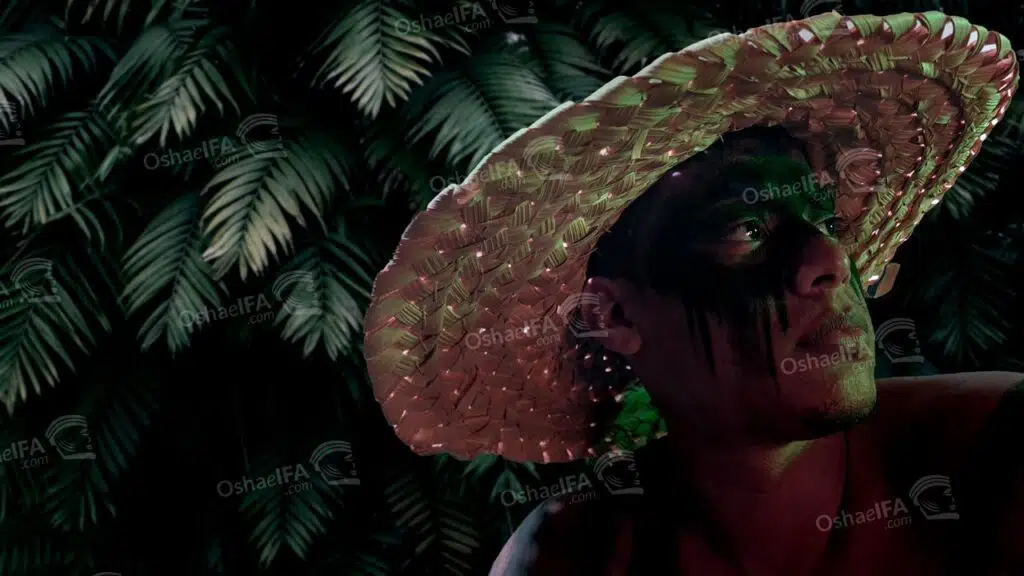
One of the basic rules of Santeria or Yoruba religion is that Ogun and Ochosi always walk together, in fact, in the Afro-Cuban tradition they surrender and live together on their foundation. even in the book Defending Our Traditions II, Gámez, Conde, and Águila de Ifá point out that:
«Regarding Oggún and Ochosi, in some regions of Nigeria these two Orishas have a close relationship and for a long time, Oggún and Ochosi walked together and adored each other, in fact, their adoration was very similar. In many lands they eat almost the same thing and have the same characteristics. In many Nigerian lands, when Oggún eats, three shots are fired into the air to call him and when Ochosi eats, he shoots once into the air to call him. (p. 11).
This belief is born from a story that is embodied in the odu of Ifa Ogunda Masa that relates the following: It happened that, although Oggun handled the machete well, he always had his food very far from his reach, because when he saw the prey, he started quickly to cut the weeds of the forest to be able to reach it, but the noise and the time it took, made his prey leave, that's why he lamented because he couldn't hunt.
On the other hand, Oshosi suffered because he managed to kill the deer, but on the other hand, he could not go and catch it among the bushes of the mountain. Meanwhile, Eshu told Ogun that there was another hunter more powerful than him, and he said the same to Ochosi, causing an enmity between them, despite the fact that they did not know each other, and the two became intrigued.
Oggun decided to go see Orunmila, and he made him osode (divination) and ordered him to do ebo. At the same time, Oshosi did the same. They both performed the recommended cleanings and went out to place them in a tree that Ifa had indicated to them.
Ogun put his ebo in the bush and leaned against the trunk, shortly after, Ochosi arrived to leave his ebo and they met there. The hunter dropped his sacrifice on Ogun, which caused a strong argument between them. However, after a while the spirits calmed down and once they were reconciled they both began to talk about their bad situation, lamenting that, despite seeing the food, both could not take it.
Then, Ochosi saw a deer in the distance, took out his arrow and hit it. And at the same time he told Oggun: «You see that I can't take it». Ogun, with his machete, opened a threshing floor and instantly, they both reached the side of the deer and ate it. And since then, they understood that separated they were nobody, so they joined forever, making a pact in Orunmila's house. This is the reason why Oggun is always delivered together with Ochosi, because in the union there is strength.
Syncretism: Who is Oggun in the Catholic religion?
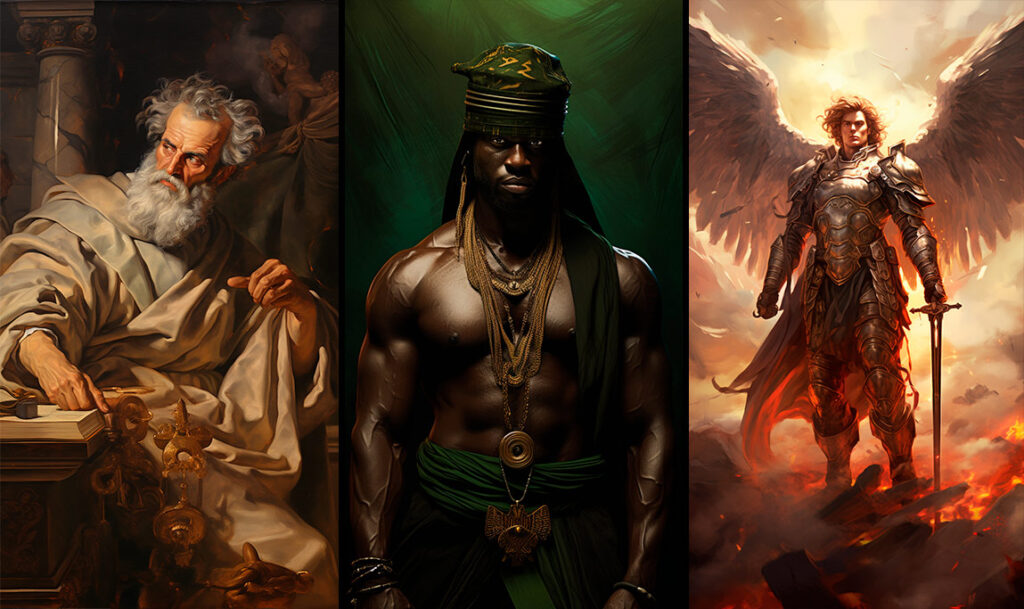
Most of the Orishas of the Yoruba pantheon tend to be syncretized with various deities from the heavenly court of the Catholic religion. Fernando Ortiz (1940), in the Cuban Bimonthly Magazine He said in this regard that:
«In religion, the Negro was comparing his myths with those of the whites and thus creating in the great mass of our base people a syncretism of equivalences so lucid and eloquent, that it is sometimes worth what a critical philosophy and opens the way for it more. unencumbered to higher forms and free to conceive the supernatural…” (p. 181).
Thus, the syncretism of the Orisha Ogún was born, which on occasions can be identified as Saint Michael the Archangel, motivated by the parity that defines them as warriors capable of ending any enemy (remember that Saint Michael the Archangel defeated the devil). Both wear clothing made of metal that serves as armor and as a fundamental tool they can never lack a weapon in their hand.
However, the most significant syncretism of Oggún is related to San Pedro, who is known as: "the rock on which the church of Christ was built." Its symbolic relationship goes beyond the fact that Pedro is the holder of the keys to heaven, whose manufacturing material is iron, making it an evident presence of Oggún in the practice of that power, since the energy of the Orisha is found Present in all metals.
To fully understand this syncretism, it is necessary to analyze the personality of both characters. Pedro turns out to be a cunning and simple man, a fisherman by profession, this denotes that he possessed a skill in his hands that generated his livelihood, until he became a "fisher of men." Beyond his fervent faith, he has had moments of weakness and has made mistakes such as denying Jesus Christ, which he later repaired, dedicating himself to evangelization and accepting the ordeal of his death.
In Ogun, we can see, in the same way, this type of situation, his actions at times are impulsive, and to repair them he works tirelessly, assuming his ordeal as his own work, without any type of complaint. We see it clearly when going into the mountains to work day and night or when supporting the Earth during eternity.
On the other hand, San Pedro turns out to be the patron saint of fishermen, builders, harvester repairmen, bakers, butchers, shoemakers, locksmiths, watchmakers and masons; professions in which Ogun undoubtedly participates, facilitating his work tools and stimulating his physical strength.
In another sense, Peter is considered one of the three columns of the Church of Jerusalem in the company of the apostles James and John; Oggun for his part belongs to the basic trilogy that opens the paths, made up of warriors, accompanied by Eleggua and Oshosi.
Even so, the characteristic that makes its syncretism decisive is the relationship that these keep with the chains, a fundamental feature in the veneration of Saint Peter that makes the implicit presence of Ogun in his cult indisputable.
The story tells that Herod Agrippa, grandson of Herod the Great, upset with the Catholic Church, had Peter arrested for being his representative, the night he intended to take him out of captivity to bring him to trial, he slept with his hands chained to each side, guarded by a couple of soldiers.
An angel appeared that night waking Peter up, and when he touched him his chains fell to the ground. The Christians understood the energetic power that these chains possessed when they considered them "blessed" by the presence of the missionary entrusted to Peter's visit, and they were guarded with deep care, attributing healing and healing powers from now on.
For 3 centuries the chains were kept in Jerusalem. In AD 437, Eudocia, who was the daughter of Emperor Thedotius the Younger, had a church built on the Esquiline Hill in Rome, where the chains of Saint Peter were venerated.
Other chains worn during Pedro's nine-month imprisonment are believed to have been guarded with equal devotion. The story goes that in the XNUMXth century, Leo I received the guarded chains from Saint Peter and when comparing them to each other, they spontaneously joined. Currently, they are kept inside a reliquary in the basilica that bears his name.
Consequently, it is impossible to overlook the importance of this element of iron in both cults. For the Yoruba, with all certainty, the energy of Ogun rests in the chains, also, let us remember that when Obatala descends to earth to finish the process of creation entrusted by Oloddumare, Ogun forged for him the chain by which he descended to the Earth, and that later, this would keep for possessing the Ashé of the Orisha of metals, therefore, its syncretism with San Pedro is more than justified, and the relationship of Oggún within the veneration of San Pedro is evident.
In other cultures from Africa such as the Palo Mayombe of Bantu origin, Oggun is syncretized with Zarabanda, deity of the mountain, owner of metal and war, who in the same way, is attributed the power to give strength to the devotees to obtain success in their struggles.
It may interest you: Paths of Oggun: The different avatars of the Iron deity
Prayers and special greetings
The way in which the Orishas are invoked or praised within Yoruba practices constitutes one of their most fundamental practices, because through ceremonial prayers it is possible to effectively connect with their energy. In Ogun's case His traditional greeting is: Ogun yee!
"Praise to the divinities reveals not only their attributes, but also the devotees' belief that their praise will draw the attention of the divinities and they will listen to requests or wishes."
De Sousa Hernandez, Adrian. The Orishas in Africa. (2005, p. 91).
Prayer (Oriki) to Ogun translated
Ba san ba pon ao lana to. Bi obi ba pon ao lana to. Borogbo ba pon ao lana to.
(Remove the roadblock. When the kola nut is ripe is when it opens the way. When the bitter result is bitter, it is when it opens the way).
B'yay yay ba pon ao lana to. B'eyin ba pon ao lana to. Da fun Ogun awo.
(When the fruit is ripe it is when it opens the way. When the palm fruit is ripe it is when it opens the way. Ogún gives him his secret).
Ni jo ti ma lana lati ode. Òrun wa si is salu aiye. Fun I'll go age. Roast.
(Dancing on the outskirts opens the way. Heaven comes to Earth. For the benefit of all people. Asé).
I sing to Oggun
Through the songs, Ogún is attracted and his energy propitiated to obtain the blessings that we are looking for. A very popular Oggun song is the following:
Guide: Ogundé Arere, Ilé gbogbo lokuowa, Ogún wa nilé, Ogún walona, Ilé gbogbo Ogún oké.
Translation: Ogún Arere is in the house, we all greet him upon his arrival, in this house we are all with the lord of iron, who is in heaven / and on the hill.
Guide: Awaniye or Ogún mariwó, Awaniye or Ogún mariwó Ogún afomodé, Onile abere mariwó, Ogundé Baba.
Translation: Ogún is the oldest in the world and yet he continues to make noise. Iron Lord, do not abandon his children in this house today. We want to know if you will continue to make noise (war). Ogún you are our father.
Guide: Awaniyé ko ma she irawo.
Translation: The greatest in this world stops his work when the stars come out.
Chorus: Awaniyé, Awaniyé ko ma she irawo, awaniyé.
Translation: The greatest in this world. The greatest in this world stops his work when the stars come out, the greatest in this world.
You can read: Prayer to Oggún: For Protection, against enemies and open the roads
Closing remarks
It has become clear that Ogun is defined as the divinity of iron and metals in the Yoruba religion. However, with respect to that particularly violent characteristic, it is necessary to make a note, because, normally, it is used as his main virtue, sometimes even the only one.
Obviously, Oggun's strength is incalculable, and indeed it is present in everything that involves violence, force and war, but not as an energetic principle that causes war, its energy is simply part of that type of situation, especially for being part of it. of the essence of the tools, or of the physical actions of man. But, the use of his energy is individual responsibility.
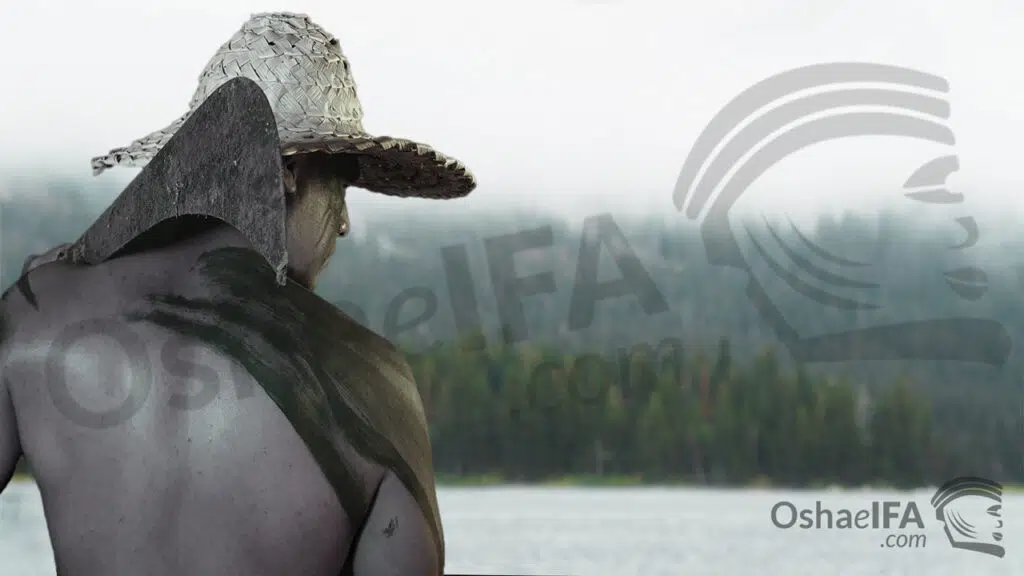
Indeed, since the oldest stories of the primitive Yoruba, Oggun has been a deity of great strength and magnitude "the warrior dressed in blood and mariwo", but he also has a large number of virtues that go beyond that characteristic. For example, Ifa Orilana Aworeni Odumola Sowunmi (2009), states that:
«Oggun is related to being dressed in blood, due to his work as a midwife, as an assistant at births, yes, a vision that is rarely worked on in the West, but he is also the midwife, long before he was transformed, thanks to some necessary distortions of history. When the African man was in his land, he highlighted the noblest characteristics of the Orisa, but once he was captive in his slavery, he prayed for Oggun, the bloody warrior to come for him, to help him and free him from oppression » . (p. 173).
This statement makes sense, given that, on the one hand, the more we investigate about this deity we find that it has amazing qualities and that many of them have been forgotten in time and, on the other hand, it is totally logical that the Yoruba in America focused on in attracting the fighting nature of his warrior deity, to propitiate the energy that would make him get out of the bitter situation in which he found himself when he was enslaved, or at least, to be able to count on the strength to resist it.
Bibliographic references
- Ifá Eagle; Gamez, Leonel & Conde, Eduardo (sf). (2012). Defending our traditions (II) Available in Águila de Ifa. Yoruba Society of Mexico and Águila de Ifá Foundation.
- Ifá eagle. (2015). Leonel Gamez Osheniwo. Teachings of a Friend, a Brother, a Teacher. Eagle of Ifá Foundation.
- Caudillo, Diane Elizabeth. (2007) Prayers to the orishas a look at Santería.
- De Sousa Hernandez, Adrian. (2005). The Orishas in Africa. An approach to our identity. Editorial of Social Sciences.
- Ifa Orilana Aworeni Odumola Sowunmi. (2009). The nature of the Orisas. Rosebud Editions.
- Ortiz, Fernando. (1940). Cuban Bimester Magazine. Vol. XLV
- R. Prandi, "African Gods in contemporary Brazil," International Sociology, p. 652.
- Shango Omo Asa. (2021). Orisha's power. Independent publication.
- Silva, Marie. (2021). Orishas: The Definitive Guide to the African Orisha Deities and Their Presence in Yoruba, Santeria, Voodoo, and Hoodoo, with an Explanation of Dilogun Divination.

